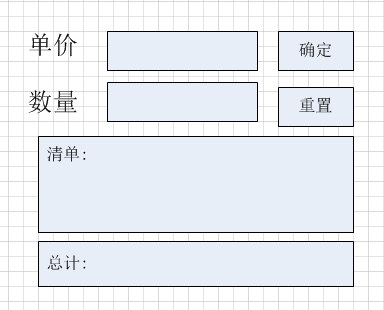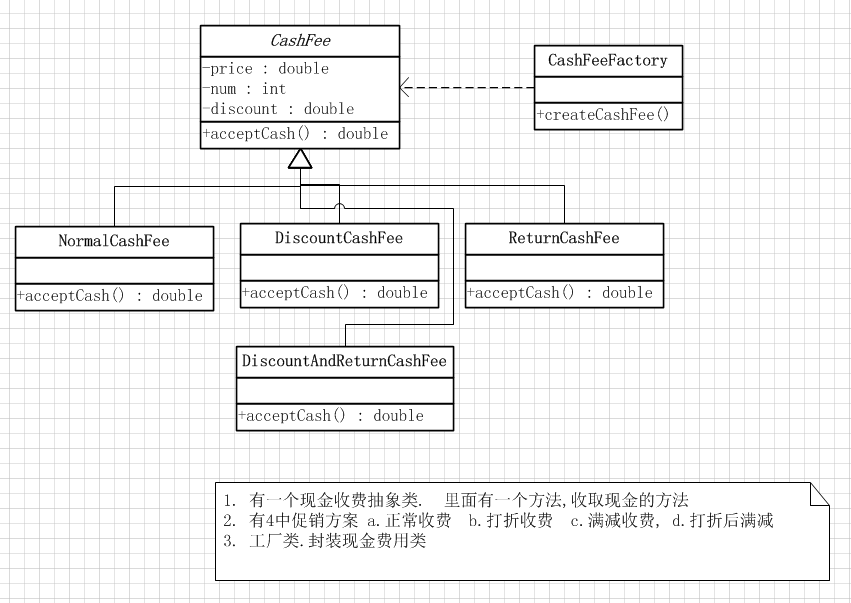策略设计模式
现在有一个需求: 给商场做一个收银软件. 营业员根据客户购买的产品的单价和数量, 向客户打印小票。

这个实现很简单. 一个类就可以搞定:
package com.designModel.chaper2_strategeModel.step1;
import java.util.Scanner;
/**
* cash收银
* @author samsung
*
*/
public class Cash {
public String list = "";
public Double totalPrice = 0.00;
public void buttonOK(){
Scanner scan = new Scanner(System.in);
System.out.println("输入单价:");
String price = scan.nextLine();
scan = new Scanner(System.in);
System.out.println("输入数量:");
String num = scan.nextLine();
scan = new Scanner(System.in);
System.out.println("输入折扣:");
String zhekou = scan.nextLine();
Double xiaoji = Double.parseDouble(price) * Integer.parseInt(num) * Double.parseDouble(zhekou)/10;
list += "单价:" + price +", 数量: "+ num +",折扣: " + zhekou + "\n";
totalPrice += xiaoji;
}
public static void main(String[] args) {
Cash cash = new Cash();
boolean flag = true;
while(flag) {
cash.buttonOK();
if(cash.totalPrice > 10){
flag = false;
}
}
System.out.println("========================");
System.out.println("清单:\n " + cash.list);
System.out.println("总价: "+ cash.totalPrice);
}
}
但是: 用面向对象的角度思考. 这个类将前端输入和业务逻辑混合在一块了. 不利于维护, 扩展, 复用, 也不灵活.
假如: 现在商场搞活动, 所有商品打折, 7折,
过一段时间, 商场又搞活动, 所有商品打5折
国庆节, 商品满200减50.
如果按照上面的方式来写代码, 那么每次都要写一遍, 如何将其复用起来呢? 并且每次增加新的活动的时候, 又不会影响到原来的活动.
对了, 简单工厂设计模式, 我们之前刚刚学过的. 下面看看简单工厂设计模式的UML图:

首先, 有一个工厂类, 在这个工厂类里面, 根据类型, 依赖于不同的现金收费方式. 具体代码如下:
首先与一个抽象的现金收费方式类:
package com.designModel.chaper2_strategeModel.step2;
/**
* 现金收费类
* @author samsung
*
*/
public abstract class CashFee {
public abstract double acceptCash(double money);
}
定义现金收费方式的实现类,分别是: 正常收费类, 折扣类, 返现类
package com.designModel.chaper2_strategeModel.step2;
//正常收费类
public class NormalCashFee extends CashFee {
@Override
public double acceptCash(double money) {
return money;
}
}
package com.designModel.chaper2_strategeModel.step2;
public class DiscountCashFee extends CashFee {
private double discount = 0.00;
public DiscountCashFee(double discount){
this.discount = discount / 10;
}
@Override
public double acceptCash(double money) {
return this.discount * money;
}
public double getDiscount() {
return discount;
}
public void setDiscount(double discount) {
this.discount = discount;
}
}
package com.designModel.chaper2_strategeModel.step2;
public class ReturnCashFee extends CashFee {
//基础金额
private double baseCash;
//返现金额
private double returnCash;
public ReturnCashFee(double baseCash, double returnCash){
this.baseCash = baseCash;
this.returnCash = returnCash;
}
@Override
public double acceptCash(double money) {
return money - Math.floor(money/300) * 50;
}
public double getBaseCash() {
return baseCash;
}
public void setBaseCash(double baseCash) {
this.baseCash = baseCash;
}
public double getReturnCash() {
return returnCash;
}
public void setReturnCash(double returnCash) {
this.returnCash = returnCash;
}
}
在定义一个工厂类, 用来产生各种现金收费方式
package com.designModel.chaper2_strategeModel.step2;
import java.util.Scanner;
public class CashFeeFactory {
public static CashFee createCashFee(int type, double discount, double basePrice, double returnPrice){
CashFee cashFee = null;
switch(type){
case 1:
cashFee = new NormalCashFee();
break;
case 2:
cashFee = new DiscountCashFee(discount);
break;
case 3:
cashFee = new ReturnCashFee(basePrice, returnPrice);
break;
}
return cashFee;
}
public static void main(String[] args) {
Scanner scan = new Scanner(System.in);
System.out.println("输入单价:");
String price = scan.nextLine();
scan = new Scanner(System.in);
System.out.println("输入数量:");
String num = scan.nextLine();
scan = new Scanner(System.in);
System.out.println("输入折扣类型(1 无折扣 2打折 3满减):");
String zhekou = scan.nextLine();
double discount = 0.0d;
double basePrice = 0;
double returnPrice = 0;
if("2".equals(zhekou)){
scan = new Scanner(System.in);
System.out.println("输入折扣:");
discount = Double.parseDouble(scan.nextLine());
}
if("3".equals(zhekou)){
scan = new Scanner(System.in);
System.out.println("基础金额:");
basePrice = Double.parseDouble(scan.nextLine());
scan = new Scanner(System.in);
System.out.println("返现金额:");
returnPrice = Double.parseDouble(scan.nextLine());
}
Double xiaoji = Double.parseDouble(price) * Integer.parseInt(num) * Double.parseDouble(zhekou)/10;
CashFee cashFee = CashFeeFactory.createCashFee(1, discount, basePrice, returnPrice);
}
}
完成了, 在main方法里, 我们模拟了客户端, 输入单价和数量,打印小票
-------------------------------------------------------------------------------------------------
思考:
使用简单工厂设计模式的优缺点:
优点:
1. 业务逻辑和前端展示相分离开了。业务逻辑的修改, 不影响前端代码
2. 每一个业务逻辑单独一个类, 修改或者添加一个类, 不会影响到其他的类.
3. 使用工厂类封装了业务逻辑类. 前端不需要知道到底每种业务逻辑具体怎么实现的. 只需要知道他的父类即可.
缺点:
1. 如果活动很频繁, 经常会搞各种各样的活动, 那么业务逻辑类就会有很多, 每一次都要增加一个类.
2. 每增加一个类都要修改工厂类. 修改会非常频繁
小结: 简单工厂设计模式虽然也能解决这个问题, 但这个模式只是解决对方的创建问题.
--------------------------------------------------------------------------
下面介绍策略设计模式:
策略(Strategy)设计模式:定义了算法家族, 分别将算法封装起来, 让他们之间可以相互替换,此模式让算法的变化不会影响到使用算法的客户。
封装变化点, 是面向对象的一种很重要的思维方式.
下面以商场促销打印收银小票为例, 来分析策略设计模式

1. 在策略设计模式中, 有各种算法: 所有的算法有一个算法父类: CashFee. 这个父类是一个抽象类. 里面有一个抽象方法acceptCash(double money)
2. 所有的算法类实现抽象算法父类, 并实现抽象方法
3. 重点: 有一个上下文对象. 这个对象封装了对算法类的调用
下面看代码:
1. 现金类算法, 以及现金的各种实现类算法
package com.designModel.chaper2_strategeModel.step3; /** * 现金收费类 * @author samsung * */ public abstract class CashFee { public abstract double acceptCash(double money); }
package com.designModel.chaper2_strategeModel.step3; //正常收费类 public class NormalCashFee extends CashFee { @Override public double acceptCash(double money) { return money; } }
package com.designModel.chaper2_strategeModel.step3; public class DiscountCashFee extends CashFee { private double discount = 0.00; public DiscountCashFee(double discount){ this.discount = discount / 10; } @Override public double acceptCash(double money) { return this.discount * money; } public double getDiscount() { return discount; } public void setDiscount(double discount) { this.discount = discount; } }
package com.designModel.chaper2_strategeModel.step3; public class ReturnCashFee extends CashFee { //基础金额 private double baseCash; //返现金额 private double returnCash; public ReturnCashFee(double baseCash, double returnCash){ this.baseCash = baseCash; this.returnCash = returnCash; } @Override public double acceptCash(double money) { return money - Math.floor(money/300) * 50; } public double getBaseCash() { return baseCash; } public void setBaseCash(double baseCash) { this.baseCash = baseCash; } public double getReturnCash() { return returnCash; } public void setReturnCash(double returnCash) { this.returnCash = returnCash; } }
最后. 来看看上下文类
package com.designModel.chaper2_strategeModel.step3; import java.util.Scanner; public class CashContext { private CashFee cashFee; public CashContext(CashFee cashFee) { this.cashFee = cashFee; } public static double getResult(double money){ CashFee cashFee = null; return cashFee.acceptCash(money); } public static void main(String[] args) { Scanner scan = new Scanner(System.in); System.out.println("输入单价:"); String price = scan.nextLine(); scan = new Scanner(System.in); System.out.println("输入数量:"); String num = scan.nextLine(); scan = new Scanner(System.in); System.out.println("输入折扣类型(1 无折扣 2打折 3满减):"); String type = scan.nextLine(); double discount = 0.0d; double basePrice = 0; double returnPrice = 0; if("2".equals(type)){ scan = new Scanner(System.in); System.out.println("输入折扣:"); discount = Double.parseDouble(scan.nextLine()); } if("3".equals(type)){ scan = new Scanner(System.in); System.out.println("基础金额:"); basePrice = Double.parseDouble(scan.nextLine()); scan = new Scanner(System.in); System.out.println("返现金额:"); returnPrice = Double.parseDouble(scan.nextLine()); } Double xianjin = Double.parseDouble(price) * Integer.parseInt(num); CashContext cc = null; switch(type){ case "1": cc = new CashContext(new NormalCashFee()); break; case "2": cc = new CashContext(new DiscountCashFee(discount)); break; case "3": cc = new CashContext(new ReturnCashFee(basePrice, returnPrice)); break; } cc.getResult(xianjin); } }
分析:
1. 业务逻辑和前端页面展示分开
2. 有一个context上下文类, 在其内部引用了CashFee类. 构造方法定义了具体的实现类.
3. 这样操作的问题: 客户端依然需要switch判断.
----------------------------------------------
策略设计模式和简单工厂设计模式相结合的方案:
其他都不变: 变化的是CashContext类
package com.designModel.chaper2_strategeModel.step4; import java.util.Scanner; public class CashContext { private CashFee cashFee; public CashContext(int type, double discount, double basePrice, double returnPrice) { switch(type){ case 1: cashFee = new NormalCashFee(); break; case 2: cashFee = new DiscountCashFee(discount); break; case 3: cashFee = new ReturnCashFee(basePrice, returnPrice); break; } } public static double getResult(double money){ CashFee cashFee = null; return cashFee.acceptCash(money); } public static void main(String[] args) { Scanner scan = new Scanner(System.in); System.out.println("输入单价:"); String price = scan.nextLine(); scan = new Scanner(System.in); System.out.println("输入数量:"); String num = scan.nextLine(); scan = new Scanner(System.in); System.out.println("输入折扣类型(1 无折扣 2打折 3满减):"); String zhekou = scan.nextLine(); double discount = 0.0d; double basePrice = 0; double returnPrice = 0; if("2".equals(zhekou)){ scan = new Scanner(System.in); System.out.println("输入折扣:"); discount = Double.parseDouble(scan.nextLine()); } if("3".equals(zhekou)){ scan = new Scanner(System.in); System.out.println("基础金额:"); basePrice = Double.parseDouble(scan.nextLine()); scan = new Scanner(System.in); System.out.println("返现金额:"); returnPrice = Double.parseDouble(scan.nextLine()); } Double xianjin = Double.parseDouble(price) * Integer.parseInt(num); CashContext cc = new CashContext(1, discount, basePrice, returnPrice); cc.getResult(xianjin); } }
我们将前端的switch转移到了CashContext的内部. 这样,前端只需要传递给我, 类型信息就可以了.
下面来看看: 简单工厂设计模式 和 策略模式+简单工厂设计模式的区别:


对于客户端而言: 简单工厂设计模式, 客户端需要知道两个类, 而简单工厂+策略设计模式, 客户端只需要知道一个类, 减低了耦合性.
---------------------------------------------------------------------------------------
思考,
书上说: 为什么要用策略设计模式呢?
因为商场打折的算法很多, 每次增加一个促销活动, 可能就会有一个新的算法. 这时候, 如果用简单工厂设计模式, 需要增加一个算法类, 同时修改工厂类. 这是, 最好使用策略设计模式.
疑问: 使用策略设计模式. 每次增加一个算法, 也要增加一个算法类, 而且要修改CashContext类. 并没有得到简化呀
应该是我修行不够, 还没能够理解, 忘懂得大神指点.